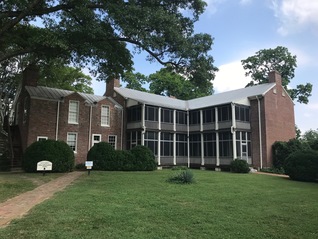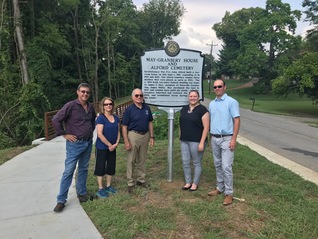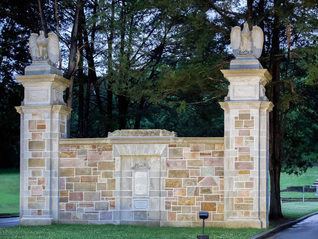|
MHC News
Historic Survey: In mid-July, MHC staff surveyed portions of
Charlotte Avenue in West Nashville. The area contains a vibrant historic
commercial corridor and many of the early- to mid-20th century
buildings remain. Within the survey area, staff documented the National
Register-listed Richland Hall building (4822 Charlotte, built 1894),
Fire Hall #13 (4406 Charlotte, built 1936), and the iconic geodesic dome
building (5100 Charlotte, built 1961), along with numerous mid-century
commercial and service-oriented business structures.
4800 block of Charlotte Avenue. Credit: MHC.
Marker Project: Several new markers will be delivered in August from Sewah Studios, including those for Paradise Ridge (District 1), Riverside Hospital/Dorothy Brown (District 2), Alexander Little Page Green (District 3), Cora Howe/Eastland (District 6), the Smith-Carter House (District 8), Odom's Tennessee Pride (District 9), and Old Hickory Works (District 11). MHC Staff will be meeting with property owners, Council members, and Public Works to place these markers in highly visible places. MHC will announce any associated public marker dedication ceremonies as those details are finalized. Check our Facebook page for updates!
The first marker of the Marker Project has been officially dedicated!
GranDale, a historic home located at 200 Nashboro Blvd., was recognized
with an historical marker on July 8th. The Marker Project was made
possible thanks to the perseverance of Councilwoman Karen Y. Johnson
(District 29), who lobbied for the funding that enables the MHC to
place new markers in all of Nashville's council districts. Councilwoman
Johnson and about twenty-five community residents attended the
dedication ceremony, which included private tours of the house and a
speech from Mayor Briley that highlighted the property's historical
significance.
Mayor Briley and Councilwoman Karen Y. Johnson (District 29) attend the GranDale marker dedication ceremony. Credit: Mayor David Briley Facebook.
On July 24th, a new marker for the May-Granbery House and Alford
Cemetery was installed on Hill Road near Granbery Elementary. The
historic property is located in Council District 4, represented by
Councilman Robert Swope. The c. 1830 Federal dwelling was home to James
F. May, grandson of Knoxville founder General James White, and the
cemetery contains headstones dating as early as 1822, including one for John Alford, a Private in the Continental Line of the Revolutionary War. Turnberry Homes is developing the land, and the MHZC
designated the property a historic landmark in April 2017.
 (above) Current views of the May-Granbery House. Credit: MHZC/MHC.
 (L to R) Councilman Robert Swope (District 4), Melinda and Charles Granbery Cornelius, Jessica Reeves (MHC) and Nicky Wells (Turnberry Homes) at the marker installation. Credit: MHC.
MHZC news
In late July, MHZC Zoning Administrator Robin Zeigler presented at the National Alliance of Preservation Commissions (NAPC) conference in Des Moines, IA. One session, "Design Review with Limited Resources," built upon the 2016 NAPC conference sessions that explored this topic. In this year's educational session, she gave updates and provided attendees with copies of her recent guide by the same name. She also led a session titled "Alternative Infill Design Review in Practice" with Nore Winter of Winter & Company. Robin is the trainer liaison for NAPC’s Commission Assistance and Mentoring Program (CAMP®).
The Eastwood Neighborhood Conservation Zoning Overlay Expansion has passed all public hearings, but still has to go before Council for final approval. The Edgehill Neighborhood Conservation Zoning Overlay has been deferred.
At the July meeting, the MHZC appointed Commissioner Menié Bell as Chair and Commissioner Cyril Stewart as Vice-Chair.
 Local author, researcher, and co-founder of Tennessee History for Kids, Bill Carey has just released a book titled "Runaways, Coffles and Fancy Girls: A History of Slavery in Tennessee." The book includes records of slave sales and related advertisements from many antebellum primary sources, including newspaper ads (1791 to 1864), Chancery Court records and city purchasing lists. Illustrated with more than 150 ads, autographed copies of the book are available for purchase through Nashville-based publisher Clearbook Press.
Another great source of information about the history of Nashville's enslaved population is the North Nashville Heritage Project (NNHP), run by Dr. Learotha Williams, an Associate Professor of African-American and public history at Tennessee State University. Dr. Williams has compiled much of his research on the NNHP website. He is also working with the Tennessee Historical Commission to place an historical marker at the site of Nashville's downtown slave market near the intersection of 4th Avenue North and Charlotte Avenue later this year.
|
Episode 4 of The Nashville Retrospect's official podcast is now available. In the latest episode, host Allen Forkum, editor of The Nashville Retrospect newspaper, talks with author Betsy Thorpe about the Dutchman's Curve tragedy, the deadliest passenger train wreck in U.S. history that occurred in West Nashville on July 9th, 1918. Thorpe discusses why there was a disproportionately high number of African-Americans killed, who was ultimately blamed for the accident, and the book she wrote, The Day the Whistles Cried.
On July 7th, as part of a weekend-long 100th anniversary memorial event, Thorpe led tours of the Dutchman's Curve tracks, now part of the Richland Creek Greenway. The private tours included talks by guest speakers and historians who helped tell the story through the lens of their respective fields of expertise. MHC staff member Scarlett Miles also assisted with the tours and spoke at the event about MHC's historical marker program.
Mayor David Briley gave opening remarks at the Dutchman's Curve 100th anniversary memorial ceremony held July 9th, which was attended by Thorpe and other historians including members of the Nashville, Chattanooga & St. Louis Preservation Society (NC&StL). Terry Coats of the NC&StL tolled a bell 101 times in memory of those who perished in the accident.
Dutchman's Curve train wreckage, 1918. Credit: TSLA.
Author Betsy Thorpe stands in front of the MHC historical marker for Dutchman's Curve Train Wreck, 2014. Credit: The Ledger.
The stone entrance gates at Percy Warner Park, built in 1932, recently underwent a historically-sensitive restoration. The local nonprofit group Friends of Warner Parks helped raise funds through the community to cover the final project cost of nearly $190,000. Between November 2017 and March 2018, the rehabilitation and restoration of the stone memorial was completed by the Tradesmen Group, Inc. Restoration Specialists. MHZC staff member Fred Zahn offered technical advice, monitored and approved the masonry work on site.
In 1927, Colonel Luke Lea, a senator, soldier and founder of The Nashville Tennessean,
donated 868 acres of land that had previously been a part of
the Belle Meade Plantation, with the condition that it would always be
used as a park. Percy Warner, Lea's father-in-law and Chairman of the Nashville Park Board, was a pioneer in electric utilities and hydroelectric development in the South. When he died unexpectedly in 1927, Colonel Lea and wife Percie (Warner) Lea immediately had the park re-named in his honor. The Park Board granted approval to fund and erect a memorial to Warner, as he loved nature and was instrumental in protecting Nashville's green spaces like Centennial Park. The Sewanee sandstone entrance topped by stone eagles and designed by architect Edward Emmett Dougherty (who also designed the War Memorial Auditorium and Nashville’s Memorial Square) was dedicated on April 26, 1932.
The Percy Warner Memorial Sandstone Entrance is a contributing structure within the Warner Park Historic District, listed in the National Register of Historic Places in 1984. The restoration of the Percy Warner Memorial Sandstone Entrance received an MHC Preservation Award in May 2018 and was re-dedicated on June 22nd.

Percy Warner Memorial Sandstone Entrance, completed restoration (top) and re-dedication ceremony with (L to R) Susan Weathersby, Councilwoman Angie Henderson (District 34), Mayor David Briley, Barby and Govan White, and Metro Parks Director Monique Odom. Credit: Friends of Warner Park.
Ellendale's restaurant, a Donelson staple for the last 19 years, has closed its doors as of July 1st. The establishment was located in a 1918 farm house that belonged to the Ezzell family. Miles Ezell, Sr. started Ezzell Dairy in 1926 and later merged the company with Gasser Brother's Rosebank Dairy. The two companies incorporated as Purity Dairy (now the only remaining dairy in the county) in 1946. The property is currently for sale for $2.55 million.
View of 2739 Old Elm Hill Pike in 2018. Credit: MHC.
National firm Heritage Consulting Group recently completed a large-scale rehabilitation of the former James Robertson Hotel. Through the use of Federal Historic Preservation Tax Incentives, the Art Deco-style hotel (now the Holston House) has been rehabilitated to showcase such historic materials and features as exterior limestone details, period iron railings and stained beams in the eclectic revival-style lobby. A new rooftop pool and bar provide great skyline views. More photos and project details can be found on HCG's project page.
Exterior of newly-rehabilitated former James Robertson Hotel, now Holston House. Credit: Heritage Consulting Group.
|